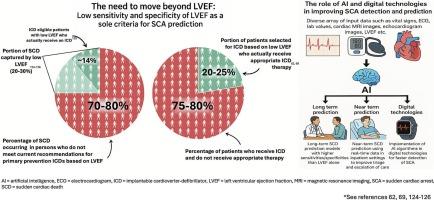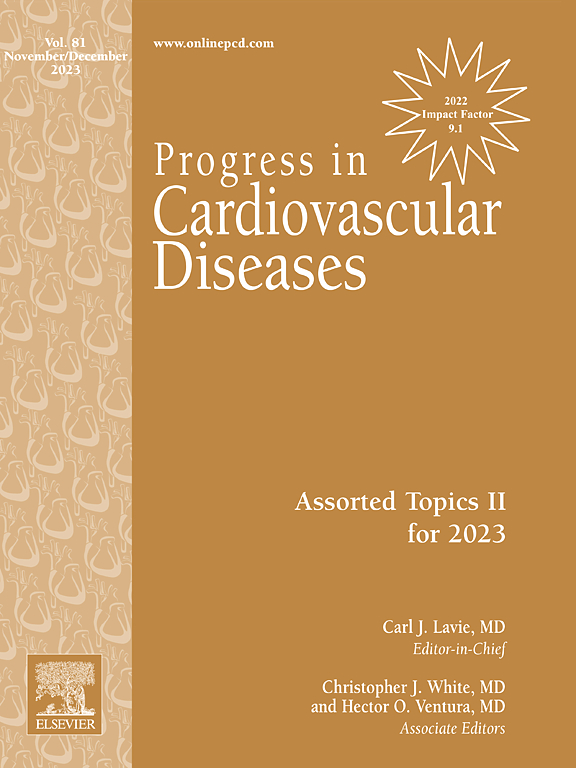Sudden cardiac arrest: Limitations in risk-stratification and treatment, and the potential for digital technologies and artificial intelligence to improve prediction and outcomes
IF 7.6
2区 医学
Q1 CARDIAC & CARDIOVASCULAR SYSTEMS
引用次数: 0
Abstract
Sudden cardiac death (SCD) remains a pervasive public health challenge, accounting for a significant proportion of cardiac and all-cause mortality worldwide. Despite notable advancements in cardiovascular therapies and reductions in overall cardiac mortality, survival following sudden cardiac arrest (SCA) remains dismally low, and prediction strategies remain inadequate. This comprehensive review examines the current landscape of SCD etiologies and the latest guidelines for primary and secondary prevention of SCD with implantable cardioverter defibrillators (ICDs). Particular attention is given to the limitations of left ventricular ejection fraction (LVEF) as the primary tool for risk stratification, given its low sensitivity, specificity, and limited applicability to the broader population in which most SCDs occur. Emerging risk scores and machine learning (ML) driven prediction models have begun to efficiently integrate clinical, electrical, imaging, genetic and laboratory parameters to improve SCD risk stratification. This review highlights examples of such artificial intelligence (AI) prediction models and discusses their potential role in the near-term and long-term prediction of SCD in both in-hospital and out-of-hospital settings, while emphasizing the need for external validation of such models. The review also discusses critical system-level gaps in the chain of survival from cardiac arrest, particularly the need for automated emergency medical services (EMS) activation, community responder engagement, high-quality cardiopulmonary resuscitation (CPR) and improved access to defibrillation. It explores the role of digital technologies such as wearable sensors, smartwatches, smartphone applications and implantable devices in improving real-time SCA detection and enhancing early aspects of the chain of survival from cardiac arrest. Finally, the review calls for a multidisciplinary, multi-sectoral approach including regulatory, technological, and public health stakeholders to bridge gaps in SCD prevention, detection, and response.

心脏骤停:风险分层和治疗的局限性,以及数字技术和人工智能改善预测和结果的潜力。
心源性猝死(SCD)仍然是一个普遍存在的公共卫生挑战,占全球心脏和全因死亡的很大比例。尽管心血管治疗取得了显著进步,心脏总死亡率降低,但心脏骤停(SCA)后的生存率仍然低得令人沮丧,预测策略仍然不足。本文综述了SCD病因学的现状,以及植入式心律转复除颤器(ICDs)一级和二级预防SCD的最新指南。鉴于左室射血分数(LVEF)的低敏感性、特异性和对大多数SCDs发生的更广泛人群的有限适用性,我们特别关注了LVEF作为风险分层主要工具的局限性。新兴的风险评分和机器学习(ML)驱动的预测模型已经开始有效地整合临床、电气、成像、遗传和实验室参数,以改善SCD风险分层。本综述重点介绍了此类人工智能(AI)预测模型的示例,并讨论了它们在院内和院外SCD近期和长期预测中的潜在作用,同时强调了对此类模型进行外部验证的必要性。该综述还讨论了心脏骤停后生存链中关键的系统级差距,特别是对自动紧急医疗服务(EMS)激活、社区响应者参与、高质量心肺复苏(CPR)和改善除颤可及性的需求。它探讨了数字技术的作用,如可穿戴传感器、智能手表、智能手机应用程序和植入式设备,在改善实时SCA检测和增强心脏骤停生存链的早期方面。最后,审查报告呼吁采取包括监管、技术和公共卫生利益攸关方在内的多学科、多部门方法,弥合SCD预防、检测和应对方面的差距。
本文章由计算机程序翻译,如有差异,请以英文原文为准。
求助全文
约1分钟内获得全文
求助全文
来源期刊

Progress in cardiovascular diseases
医学-心血管系统
CiteScore
10.90
自引率
6.60%
发文量
98
审稿时长
7 days
期刊介绍:
Progress in Cardiovascular Diseases provides comprehensive coverage of a single topic related to heart and circulatory disorders in each issue. Some issues include special articles, definitive reviews that capture the state of the art in the management of particular clinical problems in cardiology.
 求助内容:
求助内容: 应助结果提醒方式:
应助结果提醒方式:


